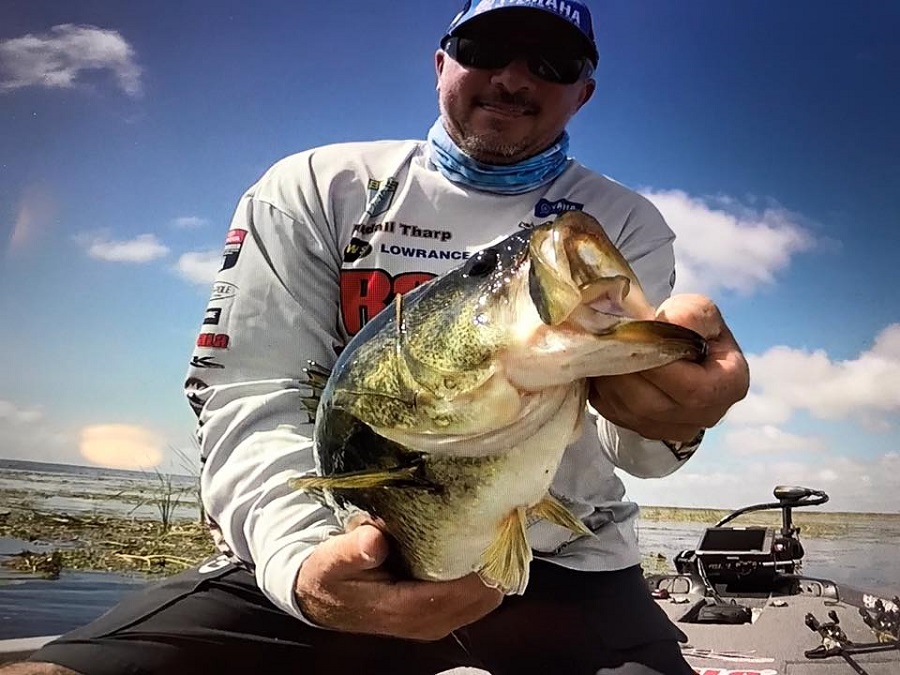
If you follow professional bass fishing, you know that Bassmaster Elite Series pro Randall Tharp likes to fish shallow and in heavy cover. He can do it all, but is most comfortable with a big rod and heavy line. He’s made a career out of fishing shallow and has a Forrest Wood Cup title to his name that was the result of fishing skinny water. Even though he would rather keep his boat shallow, he still utilizes his electronics to be successful.
“No matter what, I always have one of my graphs showing 2D Sonar and Mapping and the other I have split with StructureScan and DownScan,” he begins.
This applies to everything from inches of water to deep, offshore structure. How he utilizes the Lowrance technologies varies based on the depth he is fishing.
READ RELATED: Locating Fall Bass with Jimmy Reese
2D Sonar
The standard sonar view is helpful for locating structure and bass, but Tharp says it is perfect for determining the bottom composition, something that is essential when fishing shallow water.
“It is really easy to determine is the bottom is mucky or hard, or when it is a hard bottom compared to a rocky bottom. I think it is easier to see this on 2D Sonar compared to DownScan,” he says.
 Palette #13 /Lowrance
Palette #13 /Lowrance
Tharp prefers the Lowrance color palette #13, that he finds easiest to view the bottom and fish.
“Fish will show up as thick red or yellow lines and it is easier to see the bottom hardness and changes to it.”
 DownScan
DownScan
While 2D Sonar is his go-to for determining bottom hardness, DownScan is what he uses when fishing around grass.
“With DownScan, you can really see the thickness of the grass and even see fish within the grass. It is a little harder to make it out on 2D,” says Tharp. “I use DownScan much more on the bow that at the console.”
He is running the Lowrance HDI transducer that mounts to his trolling motor and allows for views of both 2D and DownScan.
StructureScan
Looking at your Lowrance and viewing what is to either side of the boat is often thought of as a way to find offshore structure, ledges, and generally for deep water fishing. Tharp says using it in shallow water is crucial.
“Even if you are fishing down a bank, finding those one or two different pieces of cover can be one of two more fish in a day. It could be one laydown on a whole line of bank grass or just something different,” he says. “It is easy as touching the screen and dropping a waypoint on it.”
He says that he will generally have the settings showing 80-feet to each side as he is fishing shallow cover.
“You may not even be fishing a brushpile pattern, but if you find one it can make a difference. It could be a patch of isolated rock, or just something different.” He says using StructureScan in shallow water is more about finding objects instead of locating fish like he uses it for in deeper water.
READ RELATED: Lowrance Screenshot Interpretation | Bass or Not | Scattered Rock | Bass Size
Mapping
“The mapping we have now is so good,” Tharp begins. “I still have paper maps, but I do not bring them on the boat. The electronic mapping makes it so easy to break down a lake.”
He most often uses mapping to locate new areas and then replicate his successful areas to other parts of the lake.
“If you are fishing and catching bass on shallow points, you can just zoom out and look for similar places all over the lake. When I started we were out in the boat using a paper map and we had to triangulate everything, it is so much easier now,” he says.
Settings and CHIRP
One question many anglers have about their units is how to set them up properly. Thankfully, Tharp says there are not many things he changes.
“The units are so much better than they used to be, you really do not have to change much. You used to need to adjust everything to get them dialed in,” he says.
The one setting he adjusts is the Sensitivity.
“When I am fishing around grass, I turn down the settings a little to help make it more clear and reduce clutter,” he shares.
Tharp has also become a big fan of the CHIRP technology.
“Since it has multiple frequencies being sent down from the transducer, the image is so clear. The new units just keep getting better.”
Just because you are fishing shallow water does not mean you can’t benefit from your electronics. The same principles for locating with mapping, DownScan, 2D and StructureScan that apply for deep water are just as effective in the shallow.
NEW FROM LOWRANCE HOOK2 (VIDEO BELOW)


 Advertising
Advertising